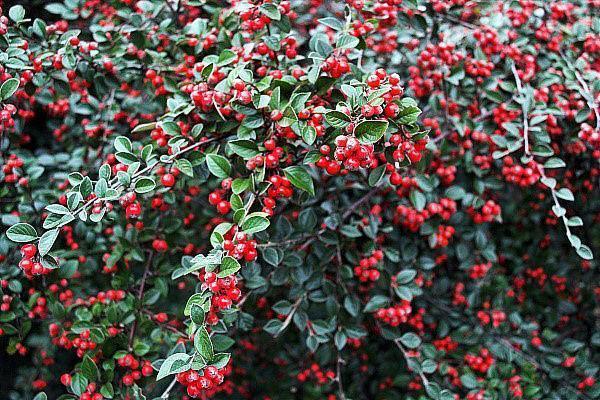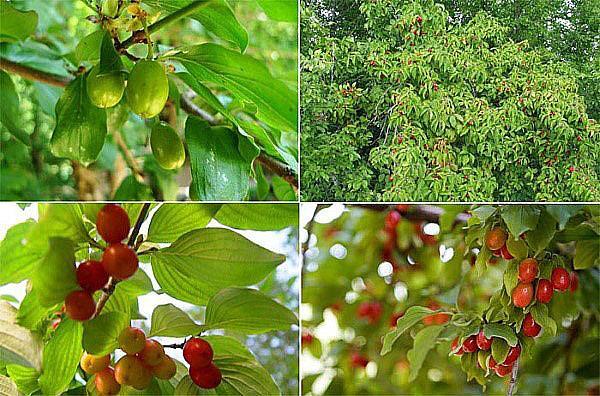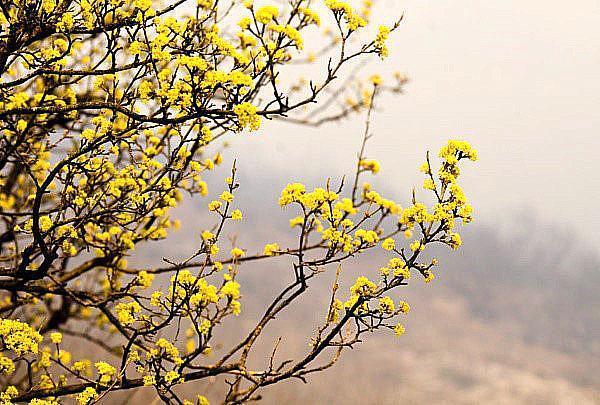A gardener's guide: everything you need to know about growing dogwood
 Dogwood is one of the long-lived gardeners undeservedly overlooked, capable of growing in one place for more than 200 years. Having begun to bear fruit at a relatively late (compared to other crops) age of about 10 years, it gives its tasty and healthy berries for more than 2/3 of its life period, and only the last few decades have the bush resting. How to grow such a culture on your site and what needs to be considered when planting and caring for it, we will talk about this today.
Dogwood is one of the long-lived gardeners undeservedly overlooked, capable of growing in one place for more than 200 years. Having begun to bear fruit at a relatively late (compared to other crops) age of about 10 years, it gives its tasty and healthy berries for more than 2/3 of its life period, and only the last few decades have the bush resting. How to grow such a culture on your site and what needs to be considered when planting and caring for it, we will talk about this today.
"Who is" dogwood?

Regardless of the species, woody variety or bushy, in the "childhood" age all plants actively grow young shoots, painted in yellow-green color, but, "growing up", the branches are covered with gray wrinkled bark, which turns red over time. The crown of the bush is round or in the form of a pyramid, and the leaves are elongated and have a sharp tip. The leaf plate is painted on top in a bright green light with a slight gloss, while on the bottom it is lighter and dull.
The leaf plate is painted on top in a bright green light with a slight gloss, while on the bottom it is lighter and dull.
Blooming dogwood is no less decorative: yellow lush umbrellas of inflorescences bloom in early spring, in March, and before the leaves peep out of the buds on the branches.
Is the berry sweet?
 In late summer - early autumn, elongated berries begin to ripen on the bushes: they are small, up to a maximum of 4 cm in length and up to 8 g each, but with very tasty and juicy pulp. Sourness prevails in the taste and a tart note is clearly felt. It has been noticed that the berries left on the bushes during the autumn frosts become sweeter.
In late summer - early autumn, elongated berries begin to ripen on the bushes: they are small, up to a maximum of 4 cm in length and up to 8 g each, but with very tasty and juicy pulp. Sourness prevails in the taste and a tart note is clearly felt. It has been noticed that the berries left on the bushes during the autumn frosts become sweeter.
The color of the berries depends on the variety, but they are mostly bright red, although breeders have bred yellow, white and different shades of red dogwood. All of them are very tasty and extremely healthy due to the rich composition of trace elements. Excellent compotes and preserves, wines and syrups are prepared from dogwood berries, as well as dried, dried and frozen. In addition, dogwood has a number of medicinal properties, which makes it an indispensable aid in the treatment of many diseases.
To prepare berries for future use, it is better to pick them when the dogwood is just beginning to ripen. Folded in boxes or wicker baskets, green berries ripen right in them.
Where can you find dogwood?
 The perennial prefers thermophilic climatic conditions and among the places where dogwood grows, it is worth noting, first of all, the mountain forests of the Transcaucasia, the Caucasus and Transcarpathia. Also, a lot of wild-growing dogwood is observed in the territory of Crimea. In the indicated area, the culture has the most optimal conditions in which it bears fruit successfully.
The perennial prefers thermophilic climatic conditions and among the places where dogwood grows, it is worth noting, first of all, the mountain forests of the Transcaucasia, the Caucasus and Transcarpathia. Also, a lot of wild-growing dogwood is observed in the territory of Crimea. In the indicated area, the culture has the most optimal conditions in which it bears fruit successfully.
The persistent nature of a perennial does not prevent it from growing even among rocks, however, this leaves an imprint on the appearance of the plant. For example, in Armenia, a dogwood in the form of a short-stemmed, low tree looks out directly from rock crevices.
On the territory of Russia as ornamental plant perennial is also used everywhere, since it has a good overall frost resistance.However, the characteristic nuances of the growing season also require a certain approach to cultivation, especially if it is planned not only to get a beautiful hedge, but also to wait for ripe red berries.
Dogwood blooms very early, and the harvest ripens for a long time (more than 200 days).
In this regard, in central Russia, it is better to plant early maturing varieties of dogwood, otherwise the ovary may suffer from recurrent frosts or the berries will not have time to ripen before the onset of autumn frosts.
Features of cultural cultivation
 Planting and caring for dogwood will not cause much trouble if you take a responsible approach to the choice of variety and place for the shrub. Only dogwood varieties that can grow and bear fruit in the local climate should be planted unambiguously. For example, in the middle latitudes, late-ripening dogwood species will not have time to ripen before the arrival of winter, which means that early varieties should be preferred.
Planting and caring for dogwood will not cause much trouble if you take a responsible approach to the choice of variety and place for the shrub. Only dogwood varieties that can grow and bear fruit in the local climate should be planted unambiguously. For example, in the middle latitudes, late-ripening dogwood species will not have time to ripen before the arrival of winter, which means that early varieties should be preferred.
When choosing a place for planting a perennial, it is better to stay in the southwestern section, which meets the following requirements (there the dogwood will grow well and bear fruit abundantly):
- groundwater is no closer than one and a half meters;
- the soil is fertile and not acidic.
It is necessary to plant dogwood at a distance of at least 5 meters from fences and trees, so that the crown can receive full lighting, and the bush has room to grow.
Dogwood in the gardens of Belarus
 Separately, it is worth mentioning the cultivation of thermophilic dogwood in Belarus - the local cold climate requires a special approach, in particular, it is better to start planting seedlings in spring, so that they have time to get stronger by winter. Those plants that are formed in the form of a shrub survive the winter best, but even they need to be covered if the average temperature in winter drops below 30 degrees below zero. To do this, the shoots are bent to the ground and covered with spruce branches.
Separately, it is worth mentioning the cultivation of thermophilic dogwood in Belarus - the local cold climate requires a special approach, in particular, it is better to start planting seedlings in spring, so that they have time to get stronger by winter. Those plants that are formed in the form of a shrub survive the winter best, but even they need to be covered if the average temperature in winter drops below 30 degrees below zero. To do this, the shoots are bent to the ground and covered with spruce branches.
As an orchard and berry crop, the main purpose of which is fruiting, on the territory of Belarus, such early varieties of dogwood with ripening at the end of summer have proven themselves well:
- Coral Stamp. Unusual dark pink berries with an orange tint ripen in the second half of August.

- Elegant. The first harvest is already at the end of July. The cherry-colored berries are in the shape of a bottle with a narrow neck and do not crumble until frost. Differs in low growth (no more than 2 m in height).

- Mid-season variety Vladimirsky. One of the largest-fruited types of dogwood, the weight of one almost black berry is about 10 g, the shape is rounded, slightly flattened. Maturation begins in the third decade of August.

Dogwood in the suburbs
 Spring planting of seedlings is also recommended when growing dogwood in the Moscow region, where winters are also cold. But local gardeners can boast of an abundance of snowfalls, which simplify measures to protect shrubs from frost: if the average winter temperature is up to 30 degrees below zero, it is enough to “barricade” the bushes with a snowdrift.
Spring planting of seedlings is also recommended when growing dogwood in the Moscow region, where winters are also cold. But local gardeners can boast of an abundance of snowfalls, which simplify measures to protect shrubs from frost: if the average winter temperature is up to 30 degrees below zero, it is enough to “barricade” the bushes with a snowdrift.
Of the frost-resistant varieties that grow well and bear fruit in the conditions of the Moscow region, it is worth noting:
- Nikolka. The dark red sweet berries ripen in early August.

- Grenadier. High-yielding variety (up to 45 kg of berries from one bush). Red elongated berries ripen in early August, taste sweet and sour.

- Helena. In late August, you can pick dark red, slightly oval, sweet-fleshed berries.

How to plant a seedling correctly?
 The most convenient way to grow dogwood is with seedlings, which can be purchased at the local nursery, where there is always a large selection of zoned varieties. What does a dogwood seedling look like? It should be:
The most convenient way to grow dogwood is with seedlings, which can be purchased at the local nursery, where there is always a large selection of zoned varieties. What does a dogwood seedling look like? It should be:
- not older and not younger than 2 years:
- with a well-developed root system;
- up to 1.5 m high;
- with a stem diameter up to 2 cm;
- with at least 5 mature skeletal branches.
The optimal planting time is autumn. For a seedling, dig a planting hole measuring 60 * 60 cm.Mix the top layer of soil with mineral fertilizers and humus and fill up the bush, deepening the root collar no more than 3 cm above the soil level (after the earth subsides, the collar should be equal to it). After watering, mulch the trunk circle and it is desirable to shorten the shoots near the bush, leaving 2/3 of their length.
Planting dogwood must be done in pairs, at a distance of 3 to 5 m from each other. This is necessary for pollination, because in early spring, when the perennial blooms, it is still cold outside and the bees have not yet begun their work.
Nuances of seed growing dogwood
 For those who like to experiment, you can try to grow a useful perennial from drupes. This procedure is quite lengthy, since they sprout for a very long time, but it will come in handy if it is problematic to purchase a ready-made seedling.
For those who like to experiment, you can try to grow a useful perennial from drupes. This procedure is quite lengthy, since they sprout for a very long time, but it will come in handy if it is problematic to purchase a ready-made seedling.
What should you pay attention to and how to grow a dogwood from a stone? First of all, this is the stratification of seeds: after harvesting, remove the pulp from ripe berries, rinse them and place them in a container with sawdust. Over the next year, the drupes should be there, while it is important to constantly maintain a high level of humidity by regularly moistening the sawdust.
Stratified drupes emerge in the year of planting, while without this procedure, seedlings should be expected for at least two years.
Prepared dogwood seeds must be planted in nutrient soil and looked after as usual: water, fertilize. It is worth considering the rate of how the dogwood grows from the seeds: in two years after germination, the seedling will stretch by only 15 cm. But the harvest from such a plant can be obtained no earlier than in 7 years. For this reason, gardeners are looking for every opportunity to buy seedlings. Buying full-fledged dogwood bushes allows you to save yourself the hassle of growing and bring fruiting closer.
Easy bush care
 Growing and caring for dogwood is generally not troublesome. In the first year, young bushes need frequent watering, with age, the perennial is already able to stay for a longer time without additional moisture. After each watering, the soil should be loosened to avoid rapid evaporation of moisture. You will also need to pull out the weeds so that they do not drown the plant. In general, everything is like other horticultural crops.
Growing and caring for dogwood is generally not troublesome. In the first year, young bushes need frequent watering, with age, the perennial is already able to stay for a longer time without additional moisture. After each watering, the soil should be loosened to avoid rapid evaporation of moisture. You will also need to pull out the weeds so that they do not drown the plant. In general, everything is like other horticultural crops.
Separately, it is worth highlighting the formation of the crown - its future contour is set even during planting or in the first year of the seedling's life, leaving a 50-centimeter stem and from 5 to 7 skeletal branches. In the future, every spring, it is necessary to carry out sanitary pruning, cutting out young shoots, damaged branches that thicken the crown, growing inside the bush or intersecting with each other.
When the dogwood is 20 years old, the bush can be rejuvenated by cutting out branches at the age of 4 years - this will stimulate the formation of new shoots.
As for fertilizing, the perennial develops well without them, especially in fertile soil, however, for a good yield, it is still recommended to fertilize the dogwood. The feeding scheme is as follows:
- in the spring - nitrogen-phosphorus preparations;
- in summer - organic (infusion of chicken droppings);
- in the fall - humus and potash fertilizers, as well as ash for digging a trunk circle.
Dogwood growing in a home garden is most often propagated vegetatively as the most effective and quickest result, namely:
- cuttings;
- layering;
- vaccination.
In conclusion, I would like to say that tasty and healthy dogwood berries must necessarily be on the site for every summer resident. This perennial will not only decorate it, but also provide its owners with natural vitamins, and more than one generation will enjoy them.